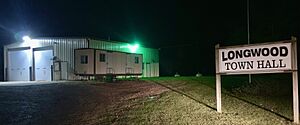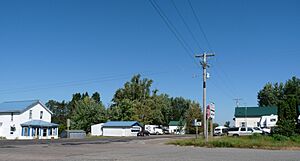Longwood, Wisconsin facts for kids
Quick facts for kids
Longwood, Wisconsin
|
|
|---|---|

Town hall
|
|

Location of Longwood, Wisconsin
|
|
| Country | |
| State | |
| County | Clark |
| Area | |
| • Total | 35.7 sq mi (92.5 km2) |
| • Land | 35.7 sq mi (92.5 km2) |
| • Water | 0.0 sq mi (0.0 km2) |
| Elevation | 1,250 ft (381 m) |
| Population
(2000)
|
|
| • Total | 698 |
| • Density | 19.6/sq mi (7.5/km2) |
| Time zone | UTC-6 (Central (CST)) |
| • Summer (DST) | UTC-5 (CDT) |
| Area code(s) | 715 & 534 |
| FIPS code | 55-45700 |
| GNIS feature ID | 1583598 |
| PLSS township | T28N R2W |
| Website | https://townoflongwood.com/ |
Longwood is a town located in Clark County, in the U.S. state of Wisconsin. In the year 2000, the population of Longwood was 698 people.
Contents
Geography of Longwood
Longwood covers a total area of about 35.7 square miles (which is about 92.5 square kilometers). Almost all of this area is land. There is only a very small amount of water within the town's borders.
History of Longwood
Early Exploration and Land Surveys
The area that is now Longwood was first mapped in June 1847. This was done by a team working for the U.S. government. They surveyed the land to create official maps. In December 1848, another team marked all the corners of the land sections. They walked through forests and swamps to do this. They used tools like a chain and a compass to measure everything.
After their work, the surveyor described the land. He said it was mostly rolling hills, with some flat areas. There were not many swamps, except along small streams. The Black River flowed through the western part of the township. The Sauteetswasin(?) River ran through the eastern part. Many small streams flowed into these rivers. The soil was generally good for farming. The area had many types of trees. These included White Pine, Birch, Sugar Maple, Elm, Oak, Hemlock, and Balsam.
Growth and Development
An 1873 map of Clark County showed a road leading to "Longwood PO." This road likely followed the path of modern Highway 73. It was probably a dirt road for wagons. The map also showed the Popple River, which had a different name in the earlier survey notes.
By 1880, Longwood was part of a larger area called Hixon. Much of the land was owned by logging companies. There were also land speculators who bought large pieces of land. The wagon road along future Highway 73 was extended. It reached the future town of Withee, where a railroad had just arrived. Other wagon roads were also built. These followed parts of what are now County N, Black River Road, and River Avenue.
The 1880 map showed about a dozen homes along these roads. There was one school south of the Longwood corner. Another school was where Black River Road meets River Avenue today. The map also showed a "flood dam." This dam helped move logs down the Popple River when the water level was low.
Changes in the Late 1800s and Early 1900s
By 1893, Longwood was still part of Hixon township. Lumber companies still owned large areas. However, more wagon roads had been built. More settlers were moving in and buying smaller pieces of land. A new schoolhouse was added. It was located where Sandy Lane Road now meets County O. A sawmill was also built on Black River Road.
A map from 1906 shows that most of the modern road system was in place. Farms were spread throughout the township. Only the far west and east sides still had large empty areas. The remaining large land blocks were mostly owned by a few individuals. The community at Longwood corner had grown. It had a blacksmith, a store, two churches, a creamery, and a school. Some rural schools had disappeared, but a new one appeared north of Eddy Road. Another church was built in the southwest part of town. By this time, the Longwood corner also had a creamery, which made dairy products.
Around 1920, another map showed the road system was complete. Most of the town was settled. Only a few areas were still owned by lumber companies. Two more cheese factories were added. One was where Colby Factory Road and River Avenue now cross. The other was where County N meets O. This shows that the area was changing. It was moving from being mainly about logging to being more about farming.
Population and People
Population Details
In the year 2000, there were 698 people living in Longwood. These people lived in 226 households, and 181 of these were families. This means there were about 19.6 people per square mile (7.5 people per square kilometer). There were 241 housing units in the town.
Most of the people in Longwood were White (99.57%). A small number were African American (0.14%). About 0.29% were from two or more races. About 0.72% of the population identified as Hispanic or Latino.
Households and Families
Out of the 226 households, 38.5% had children under 18 living with them. About 69.0% of households were married couples living together. About 6.2% had a female head of household with no husband present. About 19.9% of households were not families.
About 16.8% of all households were single individuals. About 8.8% of these individuals were 65 years old or older and lived alone. The average household had about 3.09 people. The average family had about 3.49 people.
Age and Income
The population of Longwood was spread out by age. About 34.1% of residents were under 18 years old. About 8.0% were between 18 and 24. About 21.1% were between 25 and 44. About 23.9% were between 45 and 64. Finally, about 12.9% were 65 years old or older. The average age of people in Longwood was 34 years.
The average income for a household in Longwood was $30,000. For families, the average income was $33,333. Males generally earned more than females. The average income per person in the town was $13,200.
See also
 In Spanish: Longwood (Wisconsin) para niños
In Spanish: Longwood (Wisconsin) para niños


